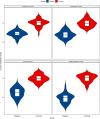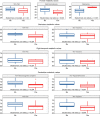18F-FDG brain PET hypometabolism in patients with long COVID
- PMID: 33501506
- PMCID: PMC7837643
- DOI: 10.1007/s00259-021-05215-4
18F-FDG brain PET hypometabolism in patients with long COVID
Abstract
Purpose: In the context of the worldwide outbreak of severe acute respiratory syndrome coronavirus 2 (SARS-CoV-2), some patients report functional complaints after apparent recovery from COVID-19. This clinical presentation has been referred as "long COVID." We here present a retrospective analysis of 18F-FDG brain PET of long COVID patients from the same center with a biologically confirmed diagnosis of SARS-CoV-2 infection and persistent functional complaints at least 3 weeks after the initial infection.
Methods: PET scans of 35 patients with long COVID were compared using whole-brain voxel-based analysis to a local database of 44 healthy subjects controlled for age and sex to characterize cerebral hypometabolism. The individual relevance of this metabolic profile was evaluated to classify patients and healthy subjects. Finally, the PET abnormalities were exploratory compared with the patients' characteristics and functional complaints.
Results: In comparison to healthy subjects, patients with long COVID exhibited bilateral hypometabolism in the bilateral rectal/orbital gyrus, including the olfactory gyrus; the right temporal lobe, including the amygdala and the hippocampus, extending to the right thalamus; the bilateral pons/medulla brainstem; the bilateral cerebellum (p-voxel < 0.001 uncorrected, p-cluster < 0.05 FWE-corrected). These metabolic clusters were highly discriminant to distinguish patients and healthy subjects (100% correct classification). These clusters of hypometabolism were significantly associated with more numerous functional complaints (brainstem and cerebellar clusters), and all associated with the occurrence of certain symptoms (hyposmia/anosmia, memory/cognitive impairment, pain and insomnia) (p < 0.05). In a more preliminary analysis, the metabolism of the frontal cluster which included the olfactory gyrus was worse in the 7 patients treated by ACE drugs for high blood pressure (p = 0.032), and better in the 3 patients that had used nasal decongestant spray at the infectious stage (p < 0.001).
Conclusion: This study demonstrates a profile of brain PET hypometabolism in long COVID patients with biologically confirmed SARS-CoV-2 and persistent functional complaints more than 3 weeks after the initial infection symptoms, involving the olfactory gyrus and connected limbic/paralimbic regions, extended to the brainstem and the cerebellum. These hypometabolisms are associated with patients' symptoms, with a biomarker value to identify and potentially follow these patients. The hypometabolism of the frontal cluster, which included the olfactory gyrus, seems to be linked to ACE drugs in patients with high blood pressure, with also a better metabolism of this olfactory region in patients using nasal decongestant spray, suggesting a possible role of ACE receptors as an olfactory gateway for this neurotropism.
Keywords: 18F-FDG; Angiotensin-converting enzyme; Anosmia; COVID-19; Complaints; Dysautonomia; Fatigue; Long COVID; Memory; PET; SARS-CoV-2; Stress.
Conflict of interest statement
The authors declare no conflict of interest.
Figures




Comment in
-
About the source and consequences of 18F-FDG brain PET hypometabolism in short and long COVID-19.Eur J Nucl Med Mol Imaging. 2021 Aug;48(9):2674-2675. doi: 10.1007/s00259-021-05342-y. Epub 2021 Apr 4. Eur J Nucl Med Mol Imaging. 2021. PMID: 33813593 Free PMC article. No abstract available.
References
-
- Meeting the challenge of long COVID. Nat Med. 2020;26:1803. doi:10.1038/s41591-020-01177-6. - PubMed
Publication types
MeSH terms
Substances
Grants and funding
LinkOut - more resources
Full Text Sources
Other Literature Sources
Medical
Miscellaneous

